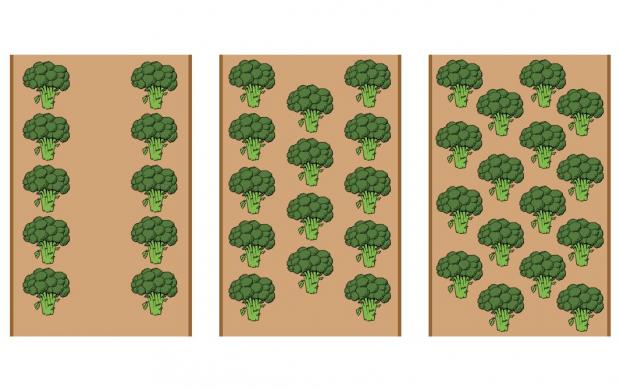Cauliflower and broccoli are generally grown at a density of 29 000 plants per hectare. However, trial work in Manjimup and Perth has shown planting density can be increased without detrimental impact on yield or quality. The results discussed below. The ideal planting density and configuration for your farm will depend on soil type, crop and variety grown, cropping rotation and market requirements for your product.
Row configuration
Planting density can be increased by reducing the within-row spacing, however there is a limit to how close plants can be placed before they become crowded. Planting density can also be increased by reducing the between-row spacing, that is increasing the number of rows per bed. This allows for increased and more even light interception and utilisation of resources such as growing area and soil nutrients.
Broccoli and cauliflower can be planted in two, three or four-row configurations. In two-row plantings seedlings are planted in line. In three and four-row configurations plants are offset from each other and shown below.

Soil type
A two or three-row configuration has been found most suitable for sandy soils. Four-row configurations are not suitable due to lower water and nutrient-holding capacity. The higher the density of the crop the greater the competition for water and nutrients between plants.
Two, three or four-row configuration is recommended on loam soils. These have higher water and nutrient-holding capacity. Compared with sand, crops on loam are able to achieve heavier and larger curds or heads at higher densities.
Cauliflower
On sandy soil the recommended planting density for cauliflower is 32 000 to 39 000 plants per hectare. In a three-row configuration this is achieved with a between-row spacing of 45cm and spacing within rows of 45 to 55cm. See Table 1 for more information on the different spacings used to reach certain planting densities.
Average curd weight tends to decrease with increasing density, while there is little change in curd size. Curd weights generally met market specifications for export and domestic markets when planted at 39 000 plants per hectare. However, at this density the percentage of curds under 500g increased, on average, by 6% compared to crops grown with 29 000 plants per hectare.
On loam soils the most suitable planting density for cauliflower was found to be 39 000 plants per hectare in a three or four-row configuration. Average curd weight generally decreased with increasing density.
Increasing density from 29 000 to 39 000 resulted in a higher percentage of curds weighing less than 500g but the percentage in the 0.9 to 1.1kg range was similar. Above 39 000 plants per hectare, average curd size was reduced by 12%.
| Plant density (No/ha) | Number of rows per bed | Within-row spacing (cm) |
|---|---|---|
| 29 000 | 2 | 40 |
| 39 000 | 2 | 30 |
| 47 000 | 2 | 25 |
| 51 000 | 2 | 23 |
| 29 000 | 3 | 60 |
| 32 000 | 3 | 55 |
| 35 000 | 3 | 50 |
| 39 000 | 3 | 45 |
| 44 000 | 3 | 40 |
| 50 000 | 3 | 35 |
| 59 000 | 3 | 30 |
| 29 000 | 4 | 80 |
| 34 000 | 4 | 70 |
| 39 000 | 4 | 60 |
| 47 000 | 4 | 50 |
| 52 000 | 4 | 45 |
Densities in this table and throughout this information have been rounded to the nearest thousand and were calculated based on a 1.7m centre-to-centre bed width with no land for spray runs and head ways taken into account.
Broccoli
Broccoli can be grown at higher density than cauliflower as it is naturally more competitive and has lower nutrient and water demands.
On sandy soil the recommended density is up to 47 000 plants per hectare in a two-row configuration. Increasing the density increased the number of marketable heads and total yield for a given area. In some crops, higher densities to 47 000 did not impact on average head weight.
In other crops higher densities did lead to lower average weight, with the percentage of heads weighing more than 500g decreasing while the percentage weighing less than 300g increased, yet the number of marketable heads remained similar.
On loam soil the recommended density is 39 000 to 52 000 plants per hectare in a two, three or four-row configuration. Average head weight decreased with higher density but most heads were still within marketable range at the recommended densities.
Average head weight was smaller but at increased planting density the total number of marketable heads harvested per hectare was greater. The highest percentages of heads in the 300-500g range were in crops with densities of 44 000 to 52 000 plants per hectare.
